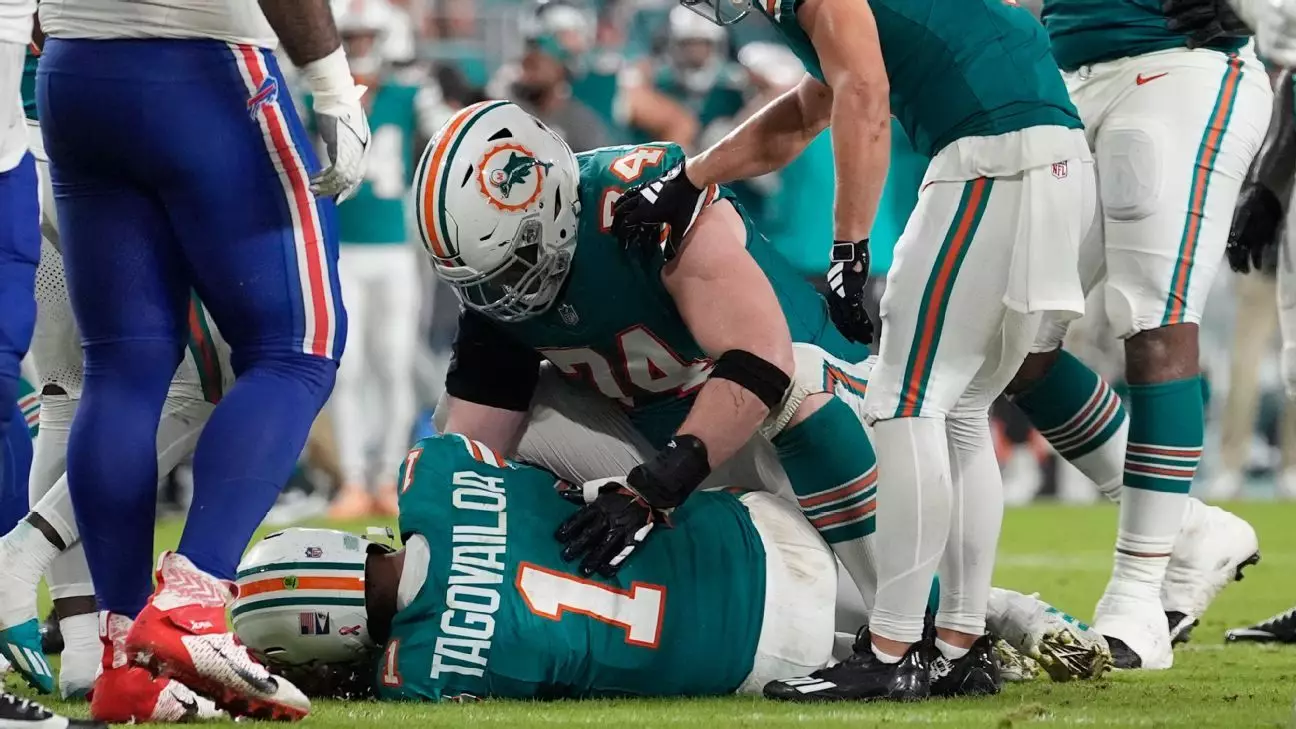The NFL has recently come under scrutiny regarding its handling of player safety, particularly concerning concussions—a topic that has become increasingly significant in the discussion of football’s impact on health. With the announcement of a record low in preseason concussions, a proactive approach to tackle this pressing issue has been emphasized. While the league continues to enforce its protocols, prominent figures within the organization, such as Dr. Allen Sills, the NFL’s chief medical officer, clarified that the responsibility for medical decisions ultimately lies with the players and their healthcare providers. This distinction is vital in ensuring that player autonomy is respected amidst the complexities of concussion management.
Tua Tagovailoa, the Miami Dolphins’ quarterback, has become a pivotal figure in discussions regarding concussions in football. Having been placed on injured reserve following a serious head injury, he symbolizes both the challenges of concussion care and the NFL’s evolving stance on player safety. Speaking during a recent conference call, Dr. Sills reiterated that Tagovailoa is under the care of top medical experts, emphasizing that decisions regarding his return to the game will be shaped by informed discussions between him and those experts. Sills’ comment on the importance of “patient autonomy and medical decision-making” highlights a broader commitment to prioritize the well-being of players over purely competitive aims.
Understanding the nuanced nature of concussions is essential. Sills stated there is no formulaic way to assess an athlete’s future risk, which can vary significantly based on individual histories and circumstances. This acknowledgment recognizes the multifaceted nature of health and highlights the limitations of applying broad metrics to complex human experiences. Instead of standard formulas, the league’s approach calls for a holistic view of a player’s health, encompassing not just the number of concussions but also their recovery timelines, symptoms, and personal sentiments regarding their career trajectory.
Season data reflects a significant milestone—the NFL reported only 44 concussions during this preseason, a 25% decrease from the previous year and the lowest number recorded since data collection commenced in 2015. This reduction stands in stark contrast to previous seasons, particularly the 91 concussions reported during the preseason of 2017. Various factors, including the implementation of new safety rules, revised practice schedules, and innovative protective gear, have all contributed to this encouraging trend.
One notable advancement is the introduction of Guardian Caps, a supplemental helmet design aimed at mitigating impact during player collisions. Initially rolled out voluntarily, the caps have now become mandatory during practices for nearly all players, excluding specialists. As acknowledged by Dr. Sills, this initiative has proven to be an “unqualified success.” By absorbing some of the forces generated during head-to-head contact, these caps are expected to play a pivotal role in reducing concussion incidents, demonstrated by the decrease observed.
Additionally, the league took proactive steps in the selection of safer helmets, allowing players to opt for models that meet safety standards, thus enhancing their protection on the field. Despite the positive results observed in practice, the same data does not yet support mandated use during games due to insufficient information on their effectiveness in live play.
Moreover, the NFL is working towards redesigning kickoff plays, with significant strides noted in reducing overall injury rates, particularly a 32% decrease in injuries related to kickoffs from 2023 figures. Despite the positive trend, the total number of concussions remains a concern, particularly during kickoffs, where a small number of head injuries have been recorded. This continued vigilance reflects the league’s commitment to adapting safety measures in a sport known for its physicality and inherent risks.
In addition, no concussions were reported on kickoffs during the first three weeks of the current regular season, which indicates that the initiatives in player safety are beginning to take significant effect. The NFL is actively committed to implementing adjustments and innovations aimed at preserving player safety at all levels, suggesting that the emphasis on neuroscience and medical input is influencing decision-making processes across the board.
As the NFL navigates the reality of concussions and player safety, it consistently reinforces the importance of expert guidance, player autonomy, and ongoing innovation. The case of Tua Tagovailoa exemplifies a broader commitment to not only individual athletes but to the entire NFL community, reflecting a trend towards a more responsive and adaptive approach to player health. The league’s focus on data-driven measures and prompt adaptations to protocols signals a meaningful shift—a dedication to creating a safer environment that respects player well-being while retaining the competitive nature of the sport. The journey is far from over, but the steps taken thus far are pivotal in shaping a brighter future for the NFL.


Leave a Reply